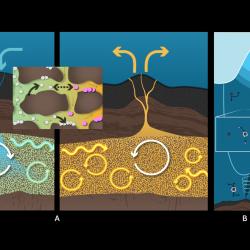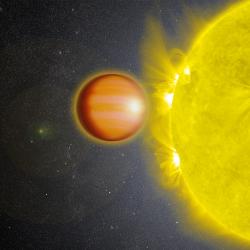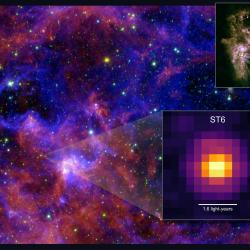Massive Boulders Ejected During DART Mission Complicate Future Asteroid Deflection Efforts
University of Maryland astronomers discovered that an unexpected blast of space rocks ejected during DART mission carried three times more momentum than the spacecraft itself, leading to new insights for future planetary defense missions.
When NASA’s DART spacecraft slammed into the asteroid moon Dimorphos in September 2022, it didn’t just change the asteroid’s orbit as intended—it unleashed a massive barrage of boulders that carried more than three times the momentum of the spacecraft itself.

A University of Maryland-led team of astronomers found that while the mission successfully proved that kinetic impactors like the DART spacecraft can alter an asteroid’s path, the resulting ejected boulders created forces in unexpected directions that could complicate future deflection efforts. According to the team’s new paper published in the Planetary Science Journal on July 4, 2025, using asteroid deflection for planetary defense is likely far more complex than researchers initially understood.
“We succeeded in deflecting an asteroid, moving it from its orbit,” said Tony Farnham, lead author of the paper and a research scientist at UMD’s Department of Astronomy. “Our research shows that while the direct impact of the DART spacecraft caused this change, the boulders ejected gave an additional kick that was almost as big. That additional factor changes the physics we need to consider when planning these types of missions.”
Using images taken by LICIACube, a small Italian spacecraft that observed DART’s aftermath, the astronomers tracked 104 boulders ranging from 0.2 to 3.6 meters in radius as they shot away from Dimorphos at speeds up to 52 meters per second (116 miles per hour). From those images, the team determined three-dimensional locations and velocities of the ejected rocks.
“We saw that the boulders weren’t scattered randomly in space,” Farnham said. “Instead, they were clustered in two pretty distinct groups, with an absence of material elsewhere, which means that something unknown is at work here.”
The largest debris cluster, containing about 70% of the measured objects, was ejected toward the south at high velocities and shallow angles to the surface. The team believes that the ejected boulders likely came from specific sources, perhaps from larger boulders on Dimorphos that were shattered by DART’s solar panels just before the main body of the spacecraft hit the surface.
“DART’s solar panels likely hit two big boulders, called Atabaque and Bodhran, on the asteroid,” explained the paper’s second author, Jessica Sunshine, a professor of astronomy and geology at UMD. “Evidence suggests that the southern cluster of ejected material is probably made up of fragments from Atabaque, a 3.3-meter-radius boulder.”
Sunshine, who also served as deputy principal investigator for the UMD-led NASA Deep Impact mission, compared DART’s results with Deep Impact’s, noting how surface features and target composition fundamentally shape impact outcomes.
“Deep Impact hit a surface that was essentially very small, uniform particles, so its ejecta was relatively smooth and continuous,” Sunshine explained. “And here, we see that DART hit a surface that was rocky and full of large boulders, resulting in chaotic and filamentary structures in its ejecta patterns. Comparing these two missions side-by-side gives us this insight into how different types of celestial bodies respond to impacts, which is crucial to ensuring that a planetary defense mission is successful.”
The momentum from the DART impact’s ejected boulders was primarily perpendicular to the spacecraft’s trajectory, meaning that it could have tilted Dimorphos’ orbital plane by up to one degree and potentially sent the asteroid tumbling erratically in space. The team’s work on understanding the effect of the boulder debris will be key to the European Space Agency’s Hera mission, which will arrive at the Didymos-Dimorphos system in 2026.
“Data gathered from LICIACube provides additional perspectives on impact events, especially as DART was originally designed to solely rely on Earth-based observations,” Farnham said. “Hera will do the same by giving us another direct view of the impact’s aftermath, relying on the predictions we’ve made using data gathered from DART.”
Farnham noted that these multiple perspectives and close-up images from LICIACube gave the DART team information that would have been impossible to detect from Earth, including data on the asteroid boulders. This new study suggests the importance of considering those variables in planning future asteroid deflection missions.
“If an asteroid was tumbling toward us, and we knew we had to move it a specific amount to prevent it from hitting Earth, then all these subtleties become very, very important,” Sunshine added. “You can think of it as a cosmic pool game. We might miss the pocket if we don’t consider all the variables.”
###
The paper, “High-Speed Boulders and the Debris Field in DART Ejecta,” was published in the Planetary Science Journal on July 4, 2025.
In addition to Farnham and Sunshine, other UMD-affiliated DART research contributors include alums Harrison Agrusa (M.S. ’19, Ph.D. ’22, astronomy) and Jian-Yang Li (M.S. ’02, Ph.D. ’05, astronomy).
This research was supported by NASA (Contract No. 80MSFC20D0004), NASA CRESST-II (Award No. 80GSFC24M0006), the U.S. Department of Energy (Contract No. DE-AC52-07NA27344. LLNL-JRNL-2002297), the French National Agency for Research (Contract No. ANR-15-IDEX-01) and the Italian Space Agency (Contract No. 2019-31-HH.0 CUP F84I190012600).







